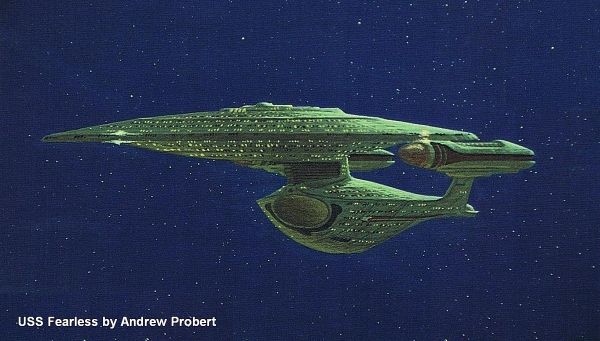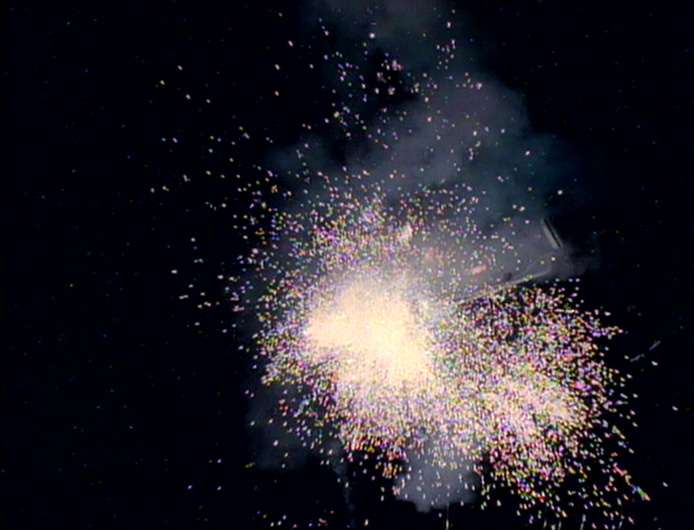I expect the most popular answer to be “like in the episode Yesterday’s Enterprise” and that’s essentially the assessment of many participants in this Trek BBS thread (starting at post # 37). One of the things I really enjoy about the Trek BBS is the inspiration I draw from the debates, good and bad, and the aforementioned one made me wonder whether the effects of the temporal and interspatial anomaly from which the Enterprise-C came out in this episode shouldn’t first be examined more thoroughly before answering the question. But first things,first.
Part I – Design Histories of the Enterprise-C
The design of the Enterprise-C in “Yesterday’s Enterprise” is noticeably different than the one on the conference lounge's sculpture wall featured visibly in many episodes during the first four seasons of TNG. Although the motif of the sculpture wall is obviously “ships named Enterprise” (because of the presence of the US Navy aircraft carrier CVN-65), it appears somewhat incomplete unless the artist wanted to limit the selection to “starships” – and what could be considered the equivalent from previous centuries.

But the spot between the Excelsior Starship Class Enterprise-B (obviously her final appearance and not the first, according to ST VII) and the Galaxy Starship Class Enterprise-D is taken by Andrew Probert’s design for the Enterprise-C, an obvious next step in design lineage from the “B” towards the “D” (Andrew Probert designed and supervised the final look of the TMP Enterprise and the TNG Enterprise-D and various other Star Trek items).

However, his design did not become “yesterday’s” Enterprise. How comes? Andrew Probert had created side views of various ships as guidance for the wall sculptor, including the Enterprise-C (above). And he had painted a visualization of the USS Fearless (below)for “Where No One Has Gone Before” to illustrate this starship class (first published and annotated in Star Trek – The Official Fan Club Magazine # 60, February 1988, in an article featuring the Star Trek Art Department and all its members), which was erroneously mislabeled in The Art of Star Trek as an early design for the Enterprise-D.

“It was done for a scene where the Enterprise was to rendezvous with this other ship. I didn’t want them to use a ship we’d already seen before (and I knew they wouldn’t spend the money to build another model) so I came up with that painting of a new design in order to establish that, parked in orbit, simply waiting for the Enterprise to get there.” (Andrew Probert)
According to the official explanation, those materials were no longer available during the pre-production of “Yesterday’s Enterprise” and because of time and budget restraints a different version had to be built by Greg Jein as a VFX model which then made it into this episode.
The designer of the “new” Enterprise-C, Rick Sternbach, never expressed or hinted any desire to excise Andrew Probert’s design from Star Trek canon with malice aforethought, so couldn’t or shouldn’t this have been an invitation to explore possibilities of co-existence of two different designs for the Enterprise-C and come up with an imaginative rationalization?
The popular explanation is simplistic, doesn’t acknowledge the wall sculpture to be canon, too (although it has been featured onscreen), and dismisses Andrew Probert’s Enterprise-C “as an artistic rendition intentionally or accidentally falsifying the ship's real look.”
(While it is obviously a changed premise, at best, or a continuity error, at worst, such a rationalization comes at the expense of real people – i.e. the original artists and producers who knew very well what they were doing and why. Andrew Probert or the wall sculptor most assuredly did not “intentionally or accidentally falsify the ship’s real look”.)
It is worth noting that the author of the above quote implies to know that the “real look” of the Enterprise-C is not the sculpture on the conference lounge wall, yet fails to consider one detail:
While we have seen an Enterprise-C in an alternate reality, we have never seen her in any episode within “our” “real” “prime” TNG time line / universe on screen. Not as a VFX model, not as a screen schematic, and not as a painting, but exclusively as that sculpture on the conference lounge wall of the Enterprise-D.
I believe it’s quite possible to have cake and eat it, too, i.e. find a palatable rationalization for two co-existing designs for the Enterprise-C which ultimately would be rather uniting than dividing. And the key may be this enigmatic temporal and interspatial anomaly that gave birth to “Yesterday’s Enterprise”.
To be continued in Part II (Alternate Realities)…stay tuned
Bob
Part I – Design Histories of the Enterprise-C
The design of the Enterprise-C in “Yesterday’s Enterprise” is noticeably different than the one on the conference lounge's sculpture wall featured visibly in many episodes during the first four seasons of TNG. Although the motif of the sculpture wall is obviously “ships named Enterprise” (because of the presence of the US Navy aircraft carrier CVN-65), it appears somewhat incomplete unless the artist wanted to limit the selection to “starships” – and what could be considered the equivalent from previous centuries.

But the spot between the Excelsior Starship Class Enterprise-B (obviously her final appearance and not the first, according to ST VII) and the Galaxy Starship Class Enterprise-D is taken by Andrew Probert’s design for the Enterprise-C, an obvious next step in design lineage from the “B” towards the “D” (Andrew Probert designed and supervised the final look of the TMP Enterprise and the TNG Enterprise-D and various other Star Trek items).

However, his design did not become “yesterday’s” Enterprise. How comes? Andrew Probert had created side views of various ships as guidance for the wall sculptor, including the Enterprise-C (above). And he had painted a visualization of the USS Fearless (below)for “Where No One Has Gone Before” to illustrate this starship class (first published and annotated in Star Trek – The Official Fan Club Magazine # 60, February 1988, in an article featuring the Star Trek Art Department and all its members), which was erroneously mislabeled in The Art of Star Trek as an early design for the Enterprise-D.

“It was done for a scene where the Enterprise was to rendezvous with this other ship. I didn’t want them to use a ship we’d already seen before (and I knew they wouldn’t spend the money to build another model) so I came up with that painting of a new design in order to establish that, parked in orbit, simply waiting for the Enterprise to get there.” (Andrew Probert)
According to the official explanation, those materials were no longer available during the pre-production of “Yesterday’s Enterprise” and because of time and budget restraints a different version had to be built by Greg Jein as a VFX model which then made it into this episode.
The designer of the “new” Enterprise-C, Rick Sternbach, never expressed or hinted any desire to excise Andrew Probert’s design from Star Trek canon with malice aforethought, so couldn’t or shouldn’t this have been an invitation to explore possibilities of co-existence of two different designs for the Enterprise-C and come up with an imaginative rationalization?
The popular explanation is simplistic, doesn’t acknowledge the wall sculpture to be canon, too (although it has been featured onscreen), and dismisses Andrew Probert’s Enterprise-C “as an artistic rendition intentionally or accidentally falsifying the ship's real look.”
(While it is obviously a changed premise, at best, or a continuity error, at worst, such a rationalization comes at the expense of real people – i.e. the original artists and producers who knew very well what they were doing and why. Andrew Probert or the wall sculptor most assuredly did not “intentionally or accidentally falsify the ship’s real look”.)
It is worth noting that the author of the above quote implies to know that the “real look” of the Enterprise-C is not the sculpture on the conference lounge wall, yet fails to consider one detail:
While we have seen an Enterprise-C in an alternate reality, we have never seen her in any episode within “our” “real” “prime” TNG time line / universe on screen. Not as a VFX model, not as a screen schematic, and not as a painting, but exclusively as that sculpture on the conference lounge wall of the Enterprise-D.
I believe it’s quite possible to have cake and eat it, too, i.e. find a palatable rationalization for two co-existing designs for the Enterprise-C which ultimately would be rather uniting than dividing. And the key may be this enigmatic temporal and interspatial anomaly that gave birth to “Yesterday’s Enterprise”.
To be continued in Part II (Alternate Realities)…stay tuned
Bob




